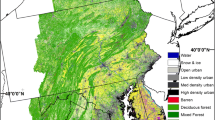Abstract
Landscape complexity in the boreal forest is a function of physiographic complexity (spatial processes) and post-fire successional (temporal) processes operating across scales. In this study we examine the role of succession and topographic complexity in determining the landscape complexity of Riding Mountain National Park, Manitoba, Canada. Landscape complexity is assessed by using multifractal analysis to quantify landscape patterns from Landsat TM imagery. To determine whether complexity changes with age, “young” sites (post-fire stand ages = 11 and 30 years) were matched with adjacent “old” sites (post-fire stand ages >95 years). The influence of physiography on landscape complexity is examined by comparing sites having “simple” and “complex” physiographies (as determined by fractal surface analysis). The scaling properties of landscape complexity are determined by calculating the multifractal spectrum (Dq) for each site. Landscape complexity increases during early succession; multifractal profiles of 11 year old sites are lower than those of adjacent older stands. However, the multifractal profiles of 30 year old and adjacent older stands are indistinguishable, suggesting that change in landscape complexity occurs within 30 years following fire. Physiographically “complex” sites have consistently greater landscape complexity than adjacent “simple” sites. We conclude that landscape complexity increases over time as succession proceeds, and in space along a gradient from “simple” to “complex” physiographies. It follows that landscape complexity is lowest in early-successional, physiographically “simple” sites and highest in late-successional, physiographically “complex” sites.
Similar content being viewed by others
Abbreviations
- DEM:
-
Digital Elevation Map
- RMNP:
-
Riding Mountain National Park
- PCA:
-
Principal Component Analysis
Author information
Authors and Affiliations
Rights and permissions
About this article
Cite this article
Walker, D.J., Kenkel, N.C. Landscape complexity in space and time. COMMUNITY ECOLOGY 2, 109–110 (2001). https://doi.org/10.1556/ComEc.2.2001.1.12
Published:
Issue Date:
DOI: https://doi.org/10.1556/ComEc.2.2001.1.12




